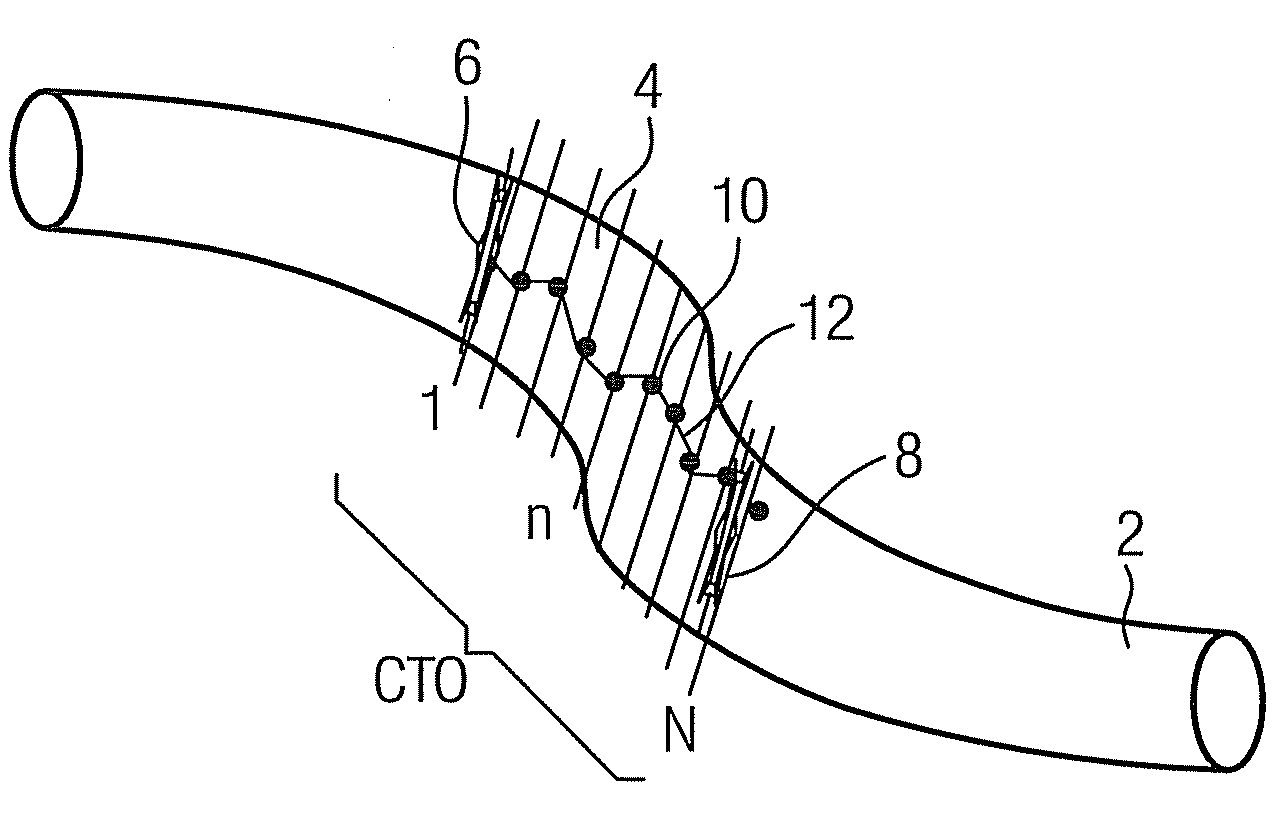[0006]It is therefore the objective of the invention to specify a method which permits—in particular for the preparation or planning of a later diagnostic, surgical or therapeutic intervention—especially simple, rapid and low risk navigation of a catheter through a blocked region of a vessel, in particular a
coronary vessel. In addition, it is to specify a medical investigation and treatment device which is particularly suitable for this purpose.
[0020]The result is that, for example, a line which is highlighted in color is overlaid on the live X-
ray projection image on the display, representing the optimal path for the catheter tip to follow as it advances, projected in the correct position in this image. As the current position of the catheter tip is generally also easy to see in the X-
ray image, at any rate if appropriate X-
ray markers are attached, the person monitoring the catheter advance or the supervising doctor or therapist can easily detect visually any deviations from the planned path, and correct them as the advance proceeds.
[0022]In particular in the case that the catheter advance is effected manually or semi-automatically, it can be logical to indicate in addition on the display, in the form of a color-coded scale or suchlike, a value characteristic of the
mechanical resistance to be expected as the catheter is advanced, derived from the sectional images or the 3D representation of the blockage region or, as appropriate, from the assigned tissue and its characteristics. This gives the medic carrying out the procedure a useful piece of additional information, so that he / she can be well prepared for the tactile conditions which are to be expected as the catheter advance proceeds.
[0023]In an embodiment, alternative or additional to that described above of an
overlay display of the real-time angiographic image with the path of least resistance merged onto or overlaid on it, it is advantageous if the display shows, apart from the real-time angiographic image, a sectional image of the blockage region, corresponding to the current position of advance of the catheter tip in the bodily vessel, recorded during the preliminary investigation. In this way, what might be called a“virtual
endoscope” is realized, so that the person carrying out the intervention or the supervising medic sees in front of them on the display a sectional view of the plaque
lying in front of the catheter tip, as though the catheter itself were equipped with an appropriate imaging sensor for in-situ imaging. The sectional views shown can then be suitably presented, e.g. by
colored highlighting of the areas of the sectional surfaces identified by the analysis
algorithm as particularly soft.
[0036]The advantages which the invention aims to achieve consist particularly in making available to the doctor or medic performing a procedure, by the appropriate
processing and visual display of medical (image) data obtained as part of a preliminary investigation, an effective
navigation aid in the planning and performance of a
catheter insertion into chronically blocked vessels, which relieves the burden on them and reduces the demands on their tactile skills and their experience. Automated, reproducible definition of the “path of least resistance” restricts the
latitude for
human decision-making, to the benefit of the medic performing the procedure, in precisely those situations in which the susceptibility to incorrect decisions, with the associated risks, is especially high. CTO treatments can thus be performed with
reduced risk, in a shorter time than hitherto, as a result of which in particular the patient's
exposure to
radiation (from the X-ray illumination which accompanies the intervention) can also be kept low.
 Login to View More
Login to View More  Login to View More
Login to View More 


